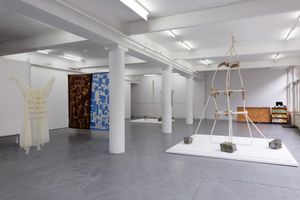Searching for Oneself Outside
–- Semâ Bekirović
- Cihad Caner
- Hans van Houwelingen, Iswanto Hartono (ruangrupa) & Mirwan Andan (ruangrupa)
- Nazif Lopulissa
- Bodil Ouédraogo
- Zela Odessa Palmer
- Jaya Pelupessy
"Public spaces are the living room of the city," declared Rabin Baldewsingh, the National Coordinator against Discrimination and Racism, in a 2023 interview with de Volkskrant. These spaces should be inclusive, providing a platform for people to exchange ideas and build relationships—where everyone feels comfortable, safe, and recognized. Baldewsingh underscores, "It is important that this public space reflects something about you and who you are."
This shared living room has evolved and transformed over centuries. It is a space we navigate daily, filled with the honoring, representation, or commemoration of individuals and histories through monuments, buildings, and street names. Like history itself, public spaces narrate an ongoing story that is never fully complete. While societies shift and our historical perspective changes, statues and monuments remain stationary, frozen in time.
Monuments and street names signify what a (city) government chooses to preserve and designate as cultural heritage, symbolizing conscious or unconscious acts of commemoration or celebration. However, what might bring pride to one person can evoke pain, anger, or shame in another, and some may remain indifferent to it all. Societies consist of individuals with diverse backgrounds, and no single representation can encompass everyone. The selection for representation in public spaces inherently involves a mechanism of exclusion. The idea that individuals or historical events exist eternally in stone or bronze has long been a topic of discussion.
Increased awareness
In The Hague, the Netherlands, and beyond, awareness about representation has grown, fueled in part by the global Black Lives Matter demonstrations following George Floyd's murder in 2020. Statues were toppled, vandalized, and inscribed upon worldwide. For example, a statue of slave trader Edward Colston in Bristol ended up in the city's canal, and the statue of King Leopold II in Antwerp was defaced, set on fire, and removed for restoration. While no statues were toppled in the Netherlands, debates arose around figures like J.P. Coen, Johan Maurits, Piet Hein, Witte de With, and Van Heutz, as well as their statues, busts, street names, and references. The question remains: How can the living room become hospitable and truly belong to everyone?
In the exhibition Searching for Oneself Outside a group of artists living and working in the Netherlands strives to shape the voices absent in our shared public spaces and provide context to those currently present. How does one give form to something invisible until now, stealthily removed in the night, or perpetually ignored?
Interviews and public programmes
During the exhibition's timeframe, the Nest website will feature weekly interviews with and texts from thinkers, artists, and writers in the "Essays & News" section. Through these publications, our aim is to initiate a conversation about shaping our collective living space. The interviews draw inspiration from the advisory report Wankele sokkels – Omstreden monumenten in de openbare ruimte which was issued by the KNAW in October 2023. This report delves into monuments situated in public spaces that are linked to the colonial past, slavery, wars, and genocide. Within the report, the Royal Netherlands Academy of Arts and Sciences (KNAW) provides recommendations on managing contentious heritage.
In addition, a comprehensive program is in the works for Searching for Oneself Outside featuring discussions, film screenings, workshops, and presentations. If you wish to participate, contribute, share a text, or propose a program idea, please sign up or reach out to us via [email protected].
- Searching for Oneself Outside press kitsDownload:Nest SF... (zip)Related to Searching for Oneself Outside
- Den Haag Centraal,Daden die niet kunnen worden weggepoetstDownload:Den Haa... (pdf)Related to Searching for Oneself Outside



